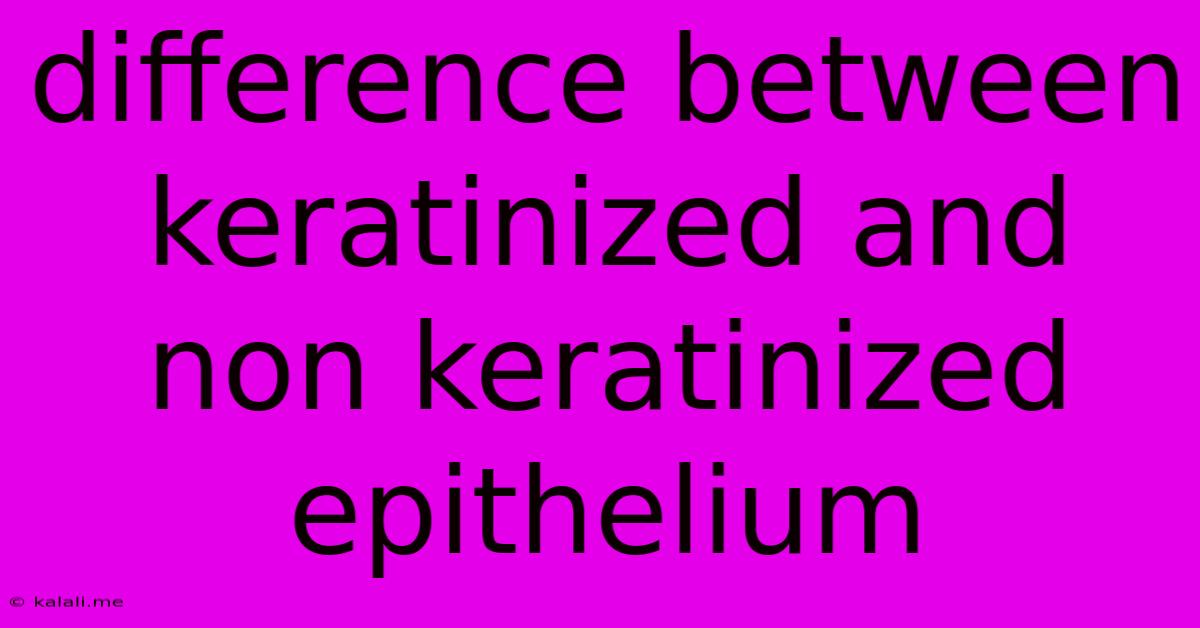Difference Between Keratinized And Non Keratinized Epithelium
Kalali
Jun 14, 2025 · 3 min read

Table of Contents
Keratinized vs. Non-Keratinized Epithelium: A Comprehensive Comparison
Epithelial tissue, a fundamental component of the body, plays a crucial role in covering surfaces and forming linings. Within epithelial tissue, we find two major subtypes: keratinized and non-keratinized epithelium. While both types share the characteristic structure of tightly packed cells, they differ significantly in their composition and function, leading to their presence in distinct locations throughout the body. This article will delve into the key distinctions between keratinized and non-keratinized epithelium, exploring their structural differences, locations within the body, and the roles they perform.
Understanding the Basics: What is Epithelium?
Epithelial tissue is characterized by its close-packed cells, minimal intercellular substance, and a basement membrane anchoring it to underlying connective tissue. It acts as a protective barrier, facilitates secretion and absorption, and plays a role in sensory perception. Understanding the basic structure of epithelium sets the stage for appreciating the differences between its keratinized and non-keratinized forms.
Key Differences Between Keratinized and Non-Keratinized Epithelium
The primary difference lies in the presence or absence of keratin, a tough, fibrous protein.
1. Keratinization:
- Definition: Keratinization is the process by which epithelial cells become filled with keratin, eventually dying and forming a tough, protective layer. This process results in a stratified squamous epithelium with several distinct layers.
- Structure: Keratinized epithelium exhibits several layers: the stratum basale (basal layer), stratum spinosum (prickly layer), stratum granulosum (granular layer), stratum lucidum (clear layer - only present in thick skin), and stratum corneum (horny layer). The stratum corneum, the outermost layer, is composed of dead, keratin-filled cells that provide a water-resistant and abrasion-resistant barrier.
- Function: Its primary function is protection against abrasion, dehydration, and infection.
- Location: Found predominantly in the epidermis of the skin, particularly the thick skin on the palms of the hands and soles of the feet.
2. Non-Keratinized Epithelium:
- Definition: Non-keratinized epithelium lacks the significant keratinization seen in its counterpart. Cells retain their nuclei and remain alive throughout all layers.
- Structure: It also typically forms a stratified squamous epithelium but lacks the extensive keratinization and distinct layering of keratinized epithelium. The cells remain moist and flexible.
- Function: Its functions primarily involve protection, but also secretion and absorption in certain locations. The lack of keratin makes it more permeable than keratinized epithelium.
- Location: Lines moist surfaces like the lining of the mouth (oral mucosa), esophagus, conjunctiva of the eye, and parts of the vagina.
Comparing Key Features in a Table:
| Feature | Keratinized Epithelium | Non-Keratinized Epithelium |
|---|---|---|
| Keratin | Present, abundant | Absent or minimal |
| Cell Nuclei | Absent in superficial layers | Present in all layers |
| Moisture | Dry, water-resistant | Moist, flexible |
| Layers | Multiple distinct layers (stratum corneum, etc.) | Multiple layers, but less distinct |
| Function | Primarily protection | Protection, secretion, absorption |
| Location | Epidermis of skin (thick skin) | Oral mucosa, esophagus, conjunctiva |
Clinical Significance
Understanding the differences between keratinized and non-keratinized epithelium is crucial in various medical fields. For example, the integrity of keratinized epithelium is essential for preventing infection and dehydration. Damage to this layer, such as in burns or wounds, can lead to significant complications. Similarly, the health of non-keratinized epithelium in areas like the oral mucosa is important for overall health and can be affected by conditions like oral lichen planus or candidiasis.
In conclusion, while both keratinized and non-keratinized epithelium are vital protective layers, their distinct structural and functional properties dictate their location and role within the body. Their differences in keratinization, moisture content, and cellular structure lead to varied functions and susceptibilities to disease. This understanding forms a crucial foundation in many areas of biology and medicine.
Latest Posts
Latest Posts
-
What Is The Opposite Of Hollow
Jun 14, 2025
-
The Image Formed In A Plane Mirror Is
Jun 14, 2025
-
What Is The Least Common Multiple Of 14 And 12
Jun 14, 2025
-
Queens University Canada Acceptance Rate International Students
Jun 14, 2025
-
What Happens When An Electron Is Removed From An Atom
Jun 14, 2025
Related Post
Thank you for visiting our website which covers about Difference Between Keratinized And Non Keratinized Epithelium . We hope the information provided has been useful to you. Feel free to contact us if you have any questions or need further assistance. See you next time and don't miss to bookmark.